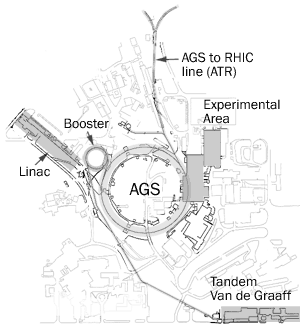Tandem Van de Graaff

The Tandem Van de Graaff is an electrostatic accelerator facility at Brookhaven National Laboratory. It was built in 1970, and was, at the time, the world's largest electrostatic accelerator facility.[1] It can provide researchers with beams of more than 40 different types of ions that have been completely stripped of their electrons, ranging from hydrogen to iron. The facility consists of two 15 million volt electrostatic accelerators, each about 24 meters long.[1]

Currently, the Tandem Van de Graaff serves as the ion source for the Relativistic Heavy Ion Collider (RHIC).[1] The ions are generated in the Tandem Van de Graaff and they then travel through a 700 meter-long tunnel called the Tandem to Booster (TtB) Line that delivers the ions to the Alternating Gradient Booster that then delivers the ions to the Alternating Gradient Synchrotron (AGS), which accelerates the ions further before final entry into RHIC.
References
- 1 2 3 "Tandem Van de Graaff". Brookhaven National Laboratory. 2008. Retrieved 2010-09-27.